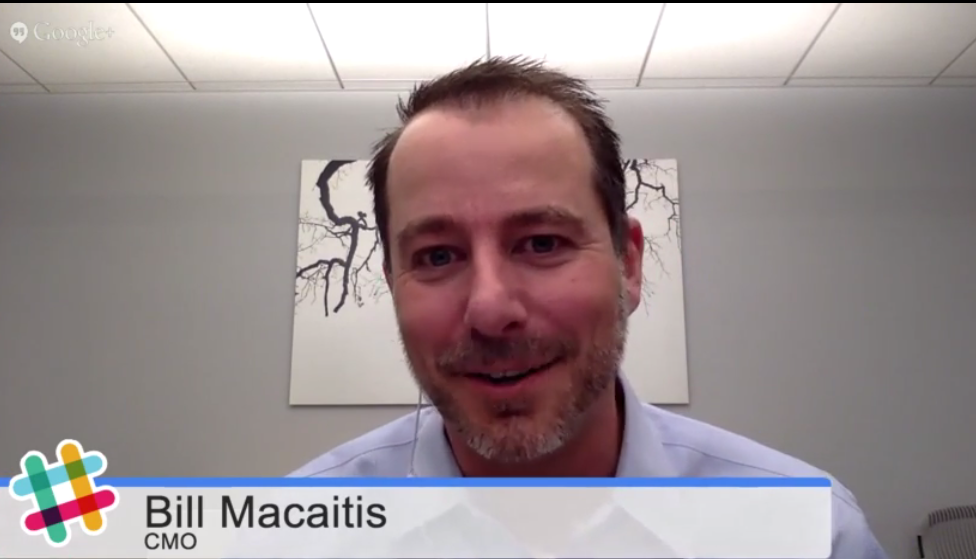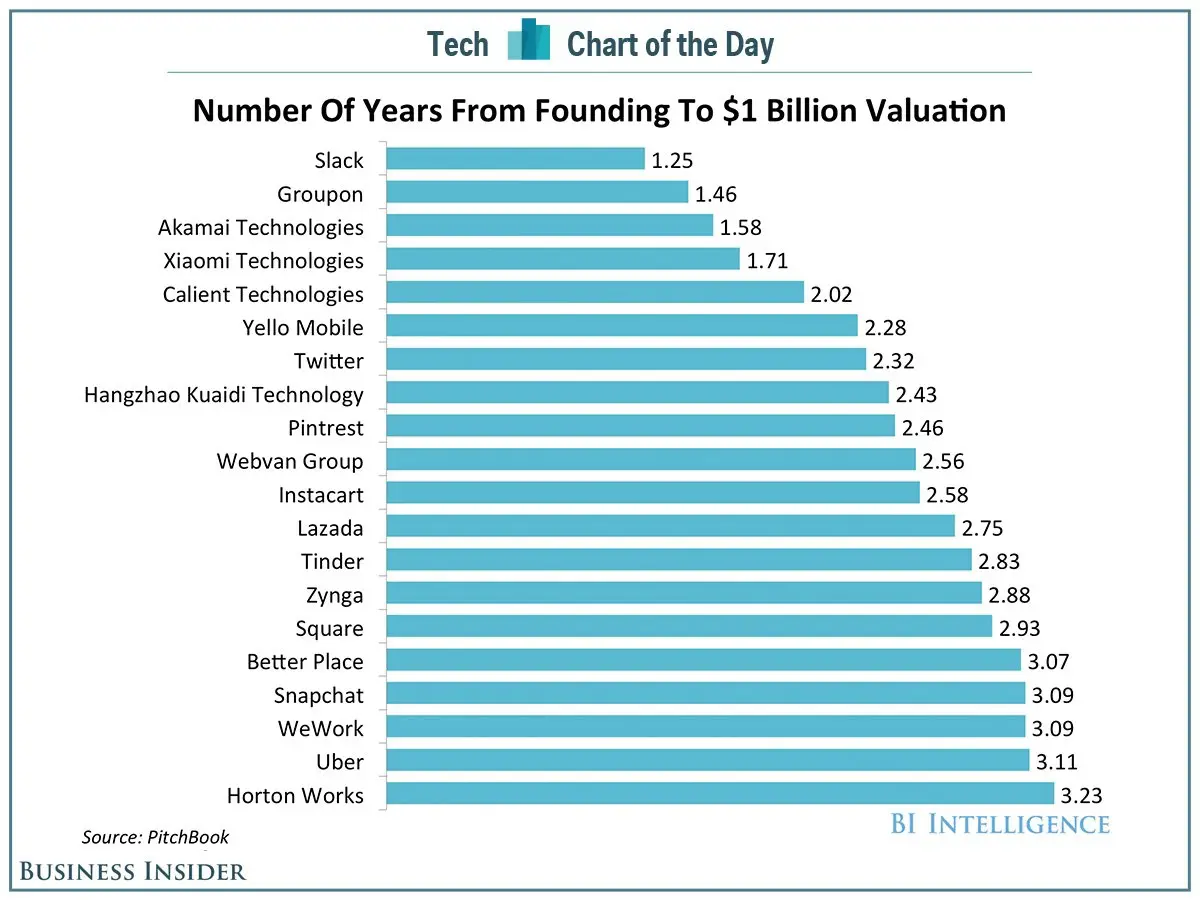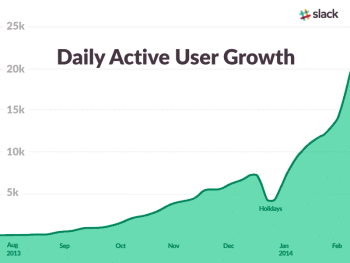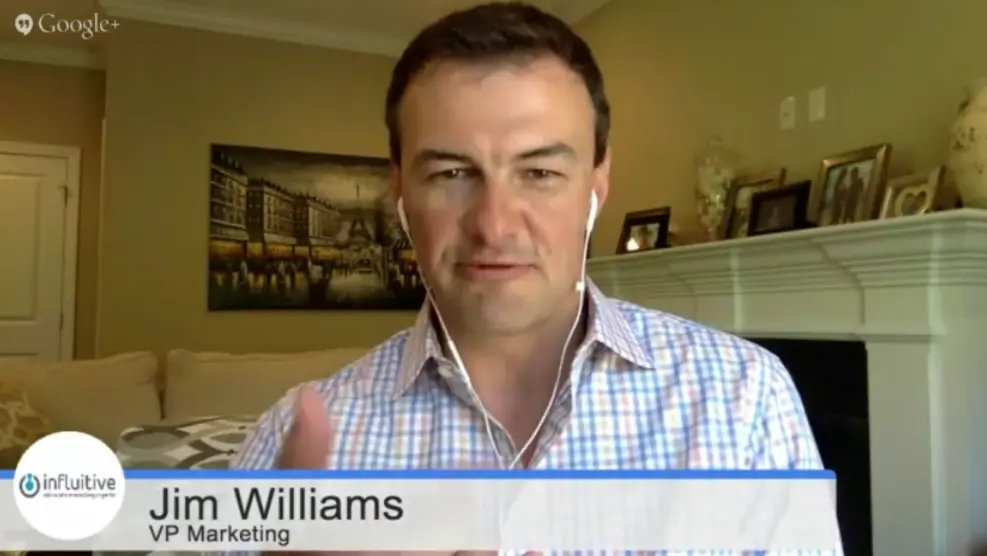What Marketers Can Learn From Slack’s CMO
Slack is on fire. The company has record-setting growth metrics. It is adding $1 million dollars of ARR every 11 days. As of April 2015, over 750,000 people use the team messaging app daily.

Cara Harshman

The entire story looks quite impressive on charts like this one:

and this one:

Source: The Verge
And it looks equally impressive through the eyes of Bill Macaitis, Slack’s Chief Marketing Officer.

Jim Williams, VP of Marketing, Influitive
Last week, Bill Macaitis opened up for a Live Ask Me Anything AMA, with Jim Williams, the VP of Marketing at Influitive, an advocate marketing company that helps companies realize and harness the power of word of mouth marketing. Word of mouth has been intrinsic to Slack‘s growth. The team messaging app radically changing how people communicate at work.
Marketers can learn a lot from Slack’s approach to marketing, especially their laser focus on creating the highest quality user experience possible — and measuring it. I’ll share a few lessons marketers can takeaway from Bill’s AMA. If you also tuned into the AMA, I’d love to hear your takeaways as well. Leave a comment!

Bill Macaitis, CMO, Slack
First, a brief background on Bill. Simply put, Bill is a world-class marketer. He joined Slack as the Chief Marketing Officer in November 2014, when the team was just two people. Today, the marketing team is 10 people and the company is 140 total. He has held either Chief or VP of Marketing roles at Zendesk, Salesforce, Fox Interactive Media, and IGN. Disrupting is one of his passions. When he joined Salesforce in 2008, the cloud was a radically different way of buying software. And now he’s back at it, marketing a product that is succeeding at fundamentally changing the way we communicate at work.
“I just absolutely love the product,” Bill said about why he took the role at Slack. “I don’t know about you guys listening in, but I feel like I’ve wasted two years of my life in status update meetings. I feel like I waste every day an hour or two trying to triage through spam, emails, all these communications in different places. And here is this solution that made my life easier— I just wanted to spread the word.”
Lessons Learned from Slack’s CMO:
Your brand is the sum of every single experience a person has with your company — online and offline.
- “Everyone impacts growth; not just marketing.”
- Bill is a big believer in team goals, especially the Net Promoter Score (NPS). Every single person at the company influences the perception and experience the brand delivers.
- In Silicon Valley we get caught up on just the product, Bill said. He is a strong advocate for taking a lifecycle view because experiences with marketing, sales, and customer success are all primary interactions a person has with the brand.
- How do you get the word of mouth engine working? It’s about taking a holistic view of the interactions a person has with the company, everything from online ads to legal terms of service.
- Bill said that tools have created siloed and biased views of the customer, pitting teams against each other. But it’s vital to analyze and optimize every one of those interactions.
NPS is the most important metric.
- The Net Promoter Score provides a north star for everyone in the company to understand.
- Bill said he is not fully satisfied if someone signs up for Slack. He is not fully satisfied is someone becomes a paying customer. Their bar is will someone recommend Slack? “And that’s a much higher bar.”
- Holistically focusing on NPS and CSAT (customer satisfaction) are long-term metrics, leading indicators of long-term growth. Leads, opportunities are short-term metrics.
- Every CEO should be able to answer this question: what are the top 3 reasons why people recommend and do not recommend your brand?
Word of mouth marketing will take you far, but not necessarily to the strategic places you want or are expecting to go.
- The role of marketing is to take a brand into new segments, new verticals. Bill says he likes to invest in best of breed new disciplines such as content marketing, evangelism, product marketing, very advanced hyper-targeted campaigns and lifecycle nurturing.
- “We’ve always tried to avoid annoying marketing tactics. One of the reasons we don’t do a lot of retargeting here,” he said.
Not everything comes down to conversion rate.
- It’s great that you can track everything, and it’s also not great that you can track everything.
- The definition of your brand is not something you go off and A/B test. Your values and messaging is something you have to decide for yourself and feel good about.
- Measuring brand has qualitative and quantitative components. Good metrics on brand side are sentiment, share of voice, aided and unaided recall. Brand metrics are more long-term.
Focus relentlessly on the customer’s experience.
- Technology isn’t everything.
- Jim asked Bill how marketers at growth-focused companies can collect the data/info they need while still creating excellent experiences for people? How should a marketer balance this?
- Bill said that when the marketing or sales team is measured solely on short-term metrics like leads, pipeline, and opportunity, then the sales and marketing teams have an incentive “to do bad things to people — to put them in those prison landing pages and start calling them before they’re ready.”
- Setting up the right long-term metrics will incentivize teams to deliver good experiences.
- At Slack, marketing, sales and success teams are measured on customer experience metrics like CSAT and NPS.
- Bill said we’re experiencing a revolution in marketing, and a shift towards programs like advocacy, lifecycle, and content marketing designed to provide a great experience to people earlier in the funnel, then identify the people that really love you and leverage that evangelism.
It doesn’t matter if you’re employed or not, it matters if you’re employable.
- Bill says this is the best piece of career advice he has ever received.
- Marketers should always be crafting their skill set, always be learning.
Other Slack facts:
- Slack has 5x more customer support representatives than sales people, a testament to their relentless focus on the customer experience.
- Some of Slack’s core company values are courtesy, empathy, and craftsmanship.
- Bill describes Slack’s billing policy as “fair”: you only have to pay if you use the product. If an account is inactive for 10 days, Slack gives a refund. “I was impressed and surprised at how many people are able to take a full 2 weeks of vacation without checking into work at all,” Bill said. “We gave out lot of refunds at that time.”
Bill’s perspective on marketing is more progressive than radical. He sees B2B marketing programs becoming more experience and advocacy-driven and believes NPS is is one of the most vital metrics. Focus on the people that love your brand, he said. Give them tools and rewards for spreading that love. It all starts with aligning teams around the right long-term and short-term goals. And he thinks that it should be marketers who educate the rest of the business and executive staff on what these metrics should be. A tall and certainly worthy order.
Did you attend? What were some of your takeaways?
